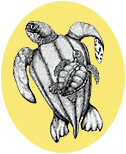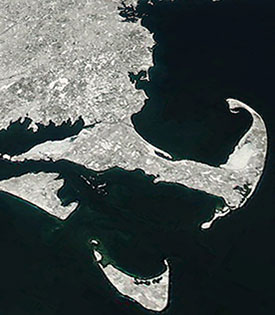Sea turtles (Leatherbacks, Loggerheads, Kemp's ridleys and Greens)
will be feeding in New England waters throughout the late spring, summer
and early fall. Boaters can help protect these endangered and threatened
species in two ways:
(1) Report sightings here, at seaturtlesightings.org. These sighting
reports help us understand annual sea turtle habitat use in our waters.
The sightings database is used by numerous scientists in their sea
turtle research. The database is also increasingly useful for
environmental assessments, such as analysis of locations for offshore
wind operations. Look at the "sighting maps" on the website to see where
different species have been reported in different years
Seasonal Updates
Spring/Summer/Early Fall 2025: Boaters Can Help Sea Turtles
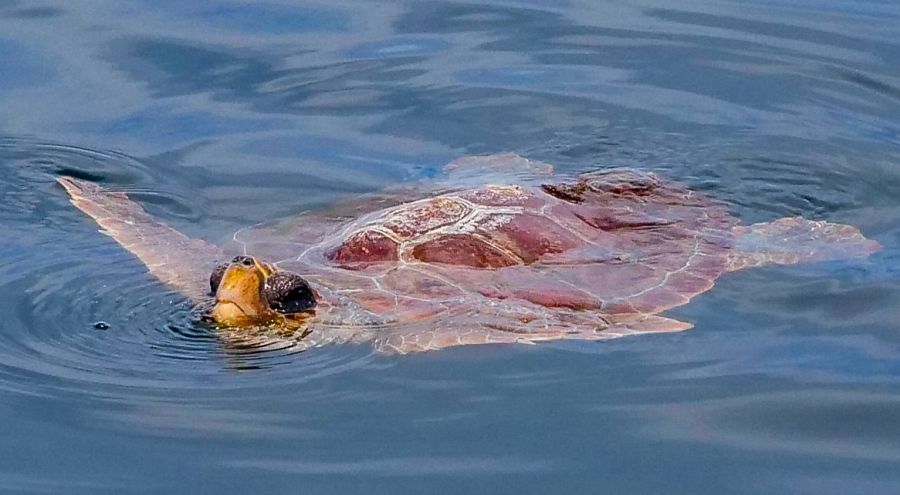
~ Loggerhead catching a breath at the surface. Photo by Susan Wrisley
(2) Watch carefully ahead of a moving vessel to avoid striking a sea turtle. Look at the photos and videos here to see what the different species might look like in the water, especially ahead of a vessel. Engage passengers to be "look-outs", which can make your time on the water much more interesting and can protect marine creatures, including sea turtles.
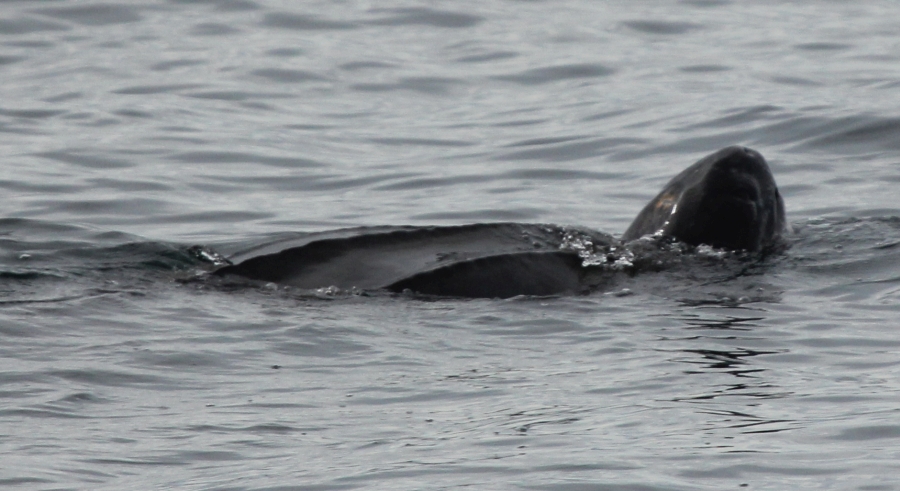
~ Swimming Leatherback, photo Melanie White, Granite State Whalewatch
Spring/Summer/Early Fall 2024: Boaters Can Help Sea Turtles
Sea turtles (Leatherbacks, Loggerheads, Kemp's ridleys and Greens)
will be feeding in New England waters throughout the late spring, summer
and early fall. Boaters can help protect these endangered and threatened
species in two ways:
(1) Report sightings here, at seaturtlesightings.org. These sighting
reports help us understand annual sea turtle habitat use in our waters.
The sightings database is used by numerous scientists in their sea
turtle research. The database is also increasingly useful for
environmental assessments, such as analysis of locations for offshore
wind operations. Look at the "sighting maps" on the website to see where
different species have been reported in different years

~ Loggerhead catching a breath at the surface. Photo by Susan Wrisley
(2) Watch carefully ahead of a moving vessel to avoid striking a sea turtle. Look at the photos and videos here to see what the different species might look like in the water, especially ahead of a vessel. Engage passengers to be "look-outs", which can make your time on the water much more interesting and can protect marine creatures, including sea turtles.

~ Swimming Leatherback, photo Melanie White, Granite State Whalewatch
Fall 2023
The cold-stunned sea turtle season is here, when live Kemp's ridleys, loggerheads and green sea turtles wash ashore, mostly on the beaches surrounding Cape Cod Bay. Occasionally, cold-stunned sea turtles wash onto the north shores of Martha's Vineyard and Nantucket, and onto shores around Buzzards Bay. All of these species are federally protected, as "endangered" or "threatened". Mass Audubon's Wellfleet Bay Wildlife Sanctuary operates a large rescue operation for these cold-stunned sea turtles, using staff and over 200 trained volunteers.
If you're walking a beach and find a stranded sea turtle, do not put it back in the water. Assume it is alive and follow these steps:
- Move it carefully to above the high tide line
- Cover it completely with seaweed, preferably dry
- Mark the spot with beach debris or draw a large arrow in the sand
- Call immediately: Wellfleet Bay Wildlife Sanctuary at 508-349-2615, ext.6104
- Report the date, town, beach and time of day
If you find a beached turtle outside of Massachusetts, please call NOAA at 866-755-6622
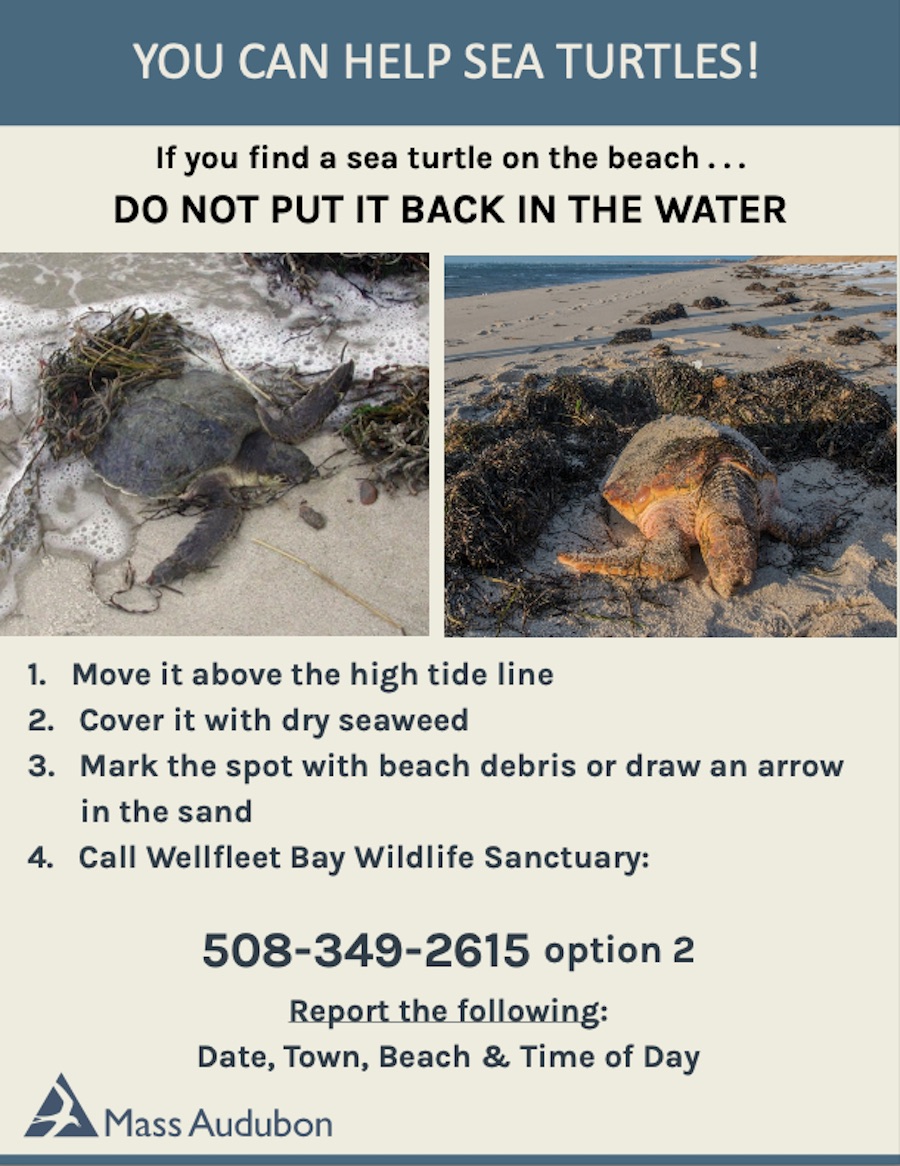
~ Beach Sign for Cold Stunned Turtles Download Printable Beach Sign
Spring/Summer/Early Fall 2023
Sea turtles (Leatherbacks, Loggerheads, Kemp's ridleys and Greens)
will be feeding in New England waters throughout the late spring, summer
and early fall. Boaters can help protect these endangered and threatened
species in two ways:
(1) Report sightings here, at seaturtlesightings.org. These sighting reports
help us understand annual sea turtle habitat use in our waters. Look at the
"sighting maps" on the website to see where different species have been
reported, which can vary from year to year.
(2) Watch carefully ahead of a moving vessel to avoid striking a sea turtle. Look at the photos and videos to
see what the different species might look like in the water, especially ahead of
a vessel. Engage passengers to be "look-outs", which can make your time on the
water much more interesting and protect marine creatures, including sea turtles.

~ Loggerhead catching a breath at the surface. Photo by Susan Wrisley
Fall 2022
The cold-stunned sea turtle season is here, when live Kemp's ridleys, loggerheads and green sea turtles wash ashore, mostly on the beaches surrounding Cape Cod Bay. Occasionally, cold-stunned sea turtles wash onto the north shores of Martha's Vineyard and Nantucket, and onto shores around Buzzards Bay. All of these species are federally protected, as "endangered" or "threatened". Mass Audubon's Wellfleet Bay Wildlife Sanctuary operates a large rescue operation for these cold-stunned sea turtles, using staff and over 200 trained volunteers.
If you're walking a beach and find a stranded sea turtle, do not put it back in the water. Assume it is alive and follow these steps:
- Move it carefully to above the high tide line
- Cover it completely with seaweed, preferably dry
- Mark the spot with beach debris or draw a large arrow in the sand
- Call immediately: Wellfleet Bay Wildlife Sanctuary at 508-349-2615, ext.6104
- Report the date, town, beach and time of day
If you find a beached turtle outside of Massachusetts, please call NOAA at 866-755-6622
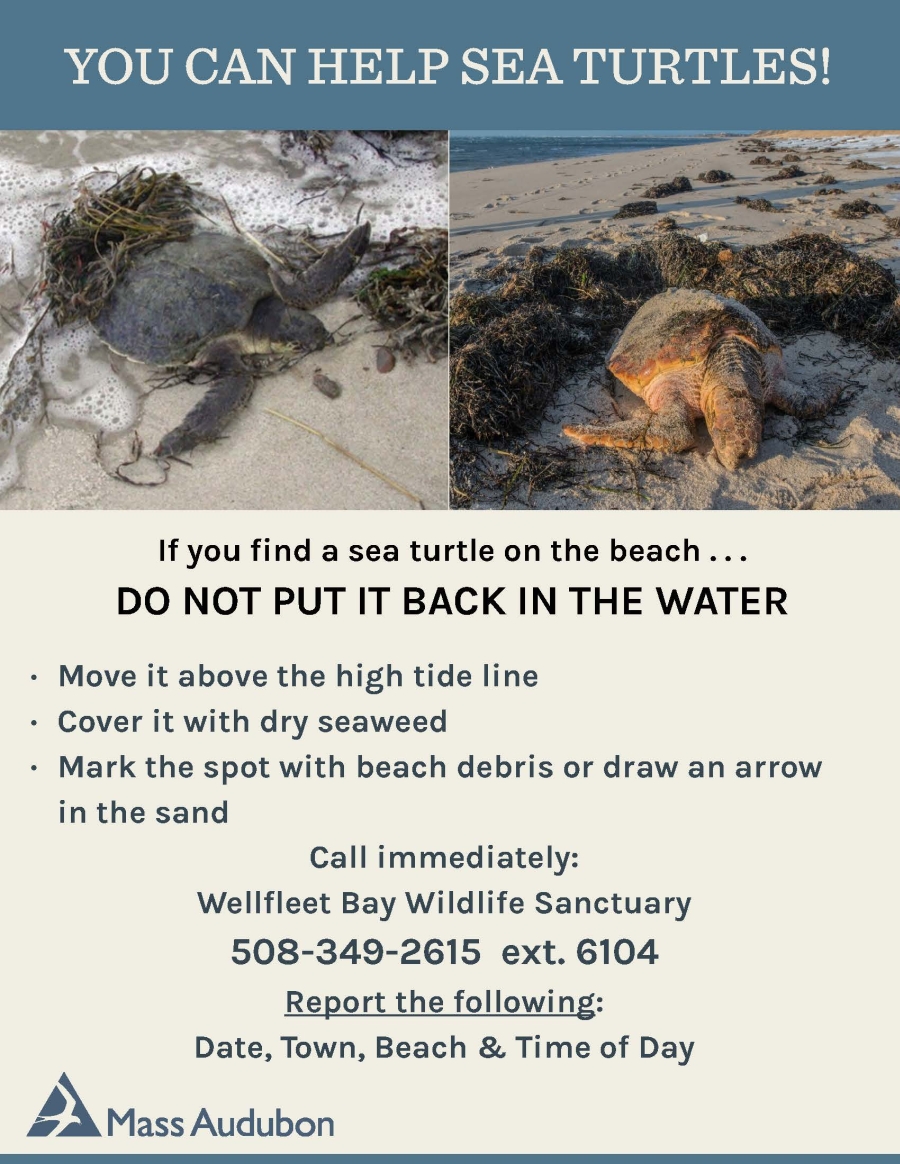
~ Beach Sign for Cold Stunned Turtles Download Printable Beach Sign
Spring/Summer/Early Fall 2022
Boaters are getting out on the water, and sea turtles will be here too, feeding in the waters off the Northeast US coast throughout the late spring, summer and fall. Marine vessel operators – recreational and commercial – can make a difference in protecting these four endangered and threatened species: leatherback, loggerhead, Kemp's ridley and green. Familiarize yourselves with what these turtles might look like in the water, using photos and videos on this website and elsewhere. Then, please do these two things:
- Report sightings here at seaturtlesightings.org to help us learn more about the sea turtles’ habitat use, which can change within a season or between years.
- Always keep a close watch ahead of your vessel to avoid striking sea turtles or other marine animals. Vessel strikes are a major cause of sea turtle mortality in our waters.
~ Leatherback Video. Courtesy of Les Hensley, in Buzzards Bay"
Fall 2021
The cold-stunned sea turtle season is here, when live Kemp's ridleys, loggerheads and green sea turtles wash ashore, mostly on the beaches surrounding Cape Cod Bay. Occasionally, cold-stunned sea turtles wash onto the north shores of Martha's Vineyard and Nantucket, and onto shores around Buzzards Bay. All of these species are federally protected, as "endangered" or "threatened". Mass Audubon's Wellfleet Bay Wildlife Sanctuary operates a large rescue operation for these cold-stunned sea turtles, using staff and over 200 trained volunteers.
If you're walking a beach and find a stranded sea turtle, do not put it back in the water. Assume it is alive and follow these steps:
- Move it carefully to above the high tide line
- Cover it completely with seaweed, preferably dry
- Mark the spot with beach debris or draw a large arrow in the sand
- Call immediately: Wellfleet Bay Wildlife Sanctuary at 508-349-2615, ext.6104
- Report the date, town, beach and time of day
If you find a beached turtle outside of Massachusetts, please call NOAA at 866-755-6622

~ Beach Sign for Cold Stunned Turtles Download Printable Beach Sign
Spring/Summer 2021
We welcome four species of feeding sea turtles back to the waters off New England! If you are a boater, please renew your commitment to watch for sea turtles to avoid striking and killing them with your vessel and report all sightings to this Mass Audubon website, seaturtlesightings.org. If you know boaters/vessel operators, please pass the word to them about watching for, and reporting, sea turtles.
We hope your sighting is a live, free-swimming sea turtle. We need to know, however, about dead turtles, so please report them, also.
Leatherbacks often feed at or near the surface, depending on location of prey. We know from tracking research that leatherbacks are so intent on feeding that they may be unaware of approaching vessels. Loggerheads are primarily bottom feeders, but they rest at the surface and can resemble a patch of brown, floating seaweed. Sea turtles at the surface can be difficult to see, but observant boaters do see and avoid them. They key word is "observant". Auto pilots do not see sea turtles!
Sighting a sea turtle is a rewarding experience, reminding us that we share our beautiful waters with many species who need our help to survive.
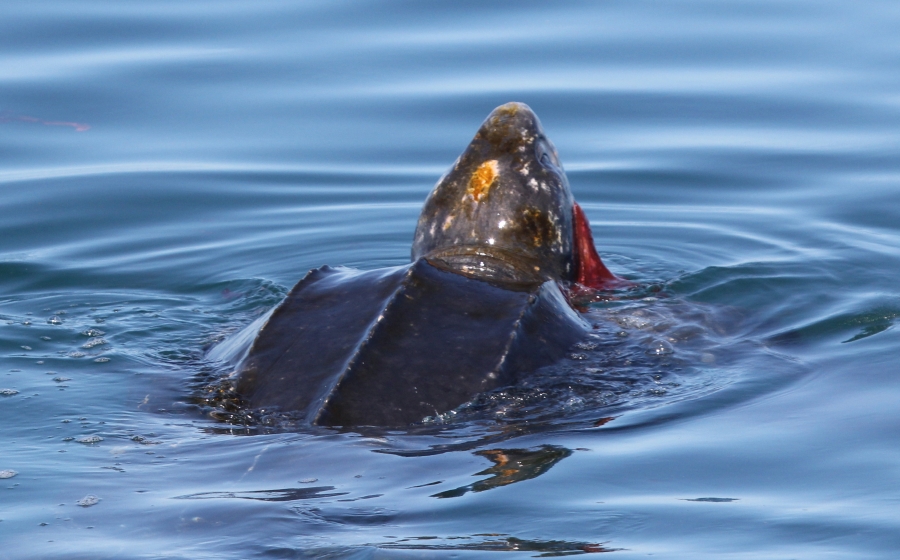
~ Leatherback eating a lion's mane jellyfish. Photo by M. White, M/V Granite State.
Fall 2020
The cold-stunned sea turtle season is here, when Kemp's ridleys, loggerheads and greens wash ashore, mostly on the beaches surrounding Cape Cod Bay, but occasionally on the north shore of Martha's Vineyard and Nantucket and around Buzzards Bay. Mass Audubon Wellfleet Bay Wildlife Sanctuary operates a large rescue operation for these cold-stuns, using sea turtle staff and over 200 trained volunteers. If you're walking a beach and find a stranded sea turtle, assume that the turtle is alive and please follow these steps:
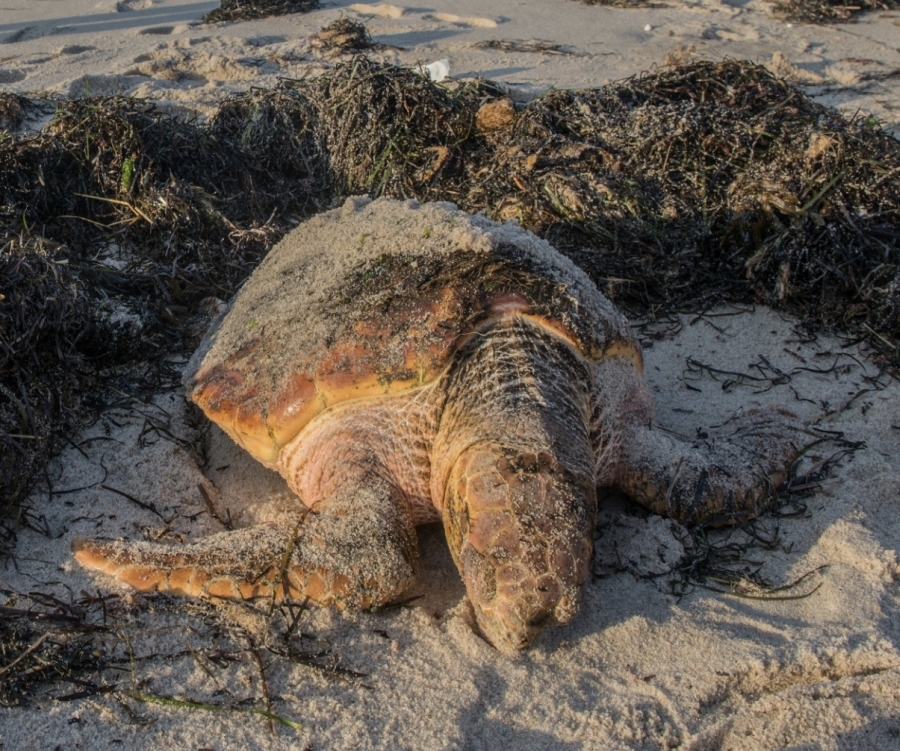
~ Cold-stunned loggerhead sea turtle.
- Move turtle to above the high tide line
- Cover it completely with dry seaweed (wet if dry not available)
- Clearly mark it with piece of debris or draw arrow in sand pointing to covered turtle
- If in Massachusetts call Mass Audubon Wellfleet Bay at 508-349-2615 ext. 6104
- If in another state call NOAA at 866-755-6622
Do not attempt to warm turtle—this will kill it!
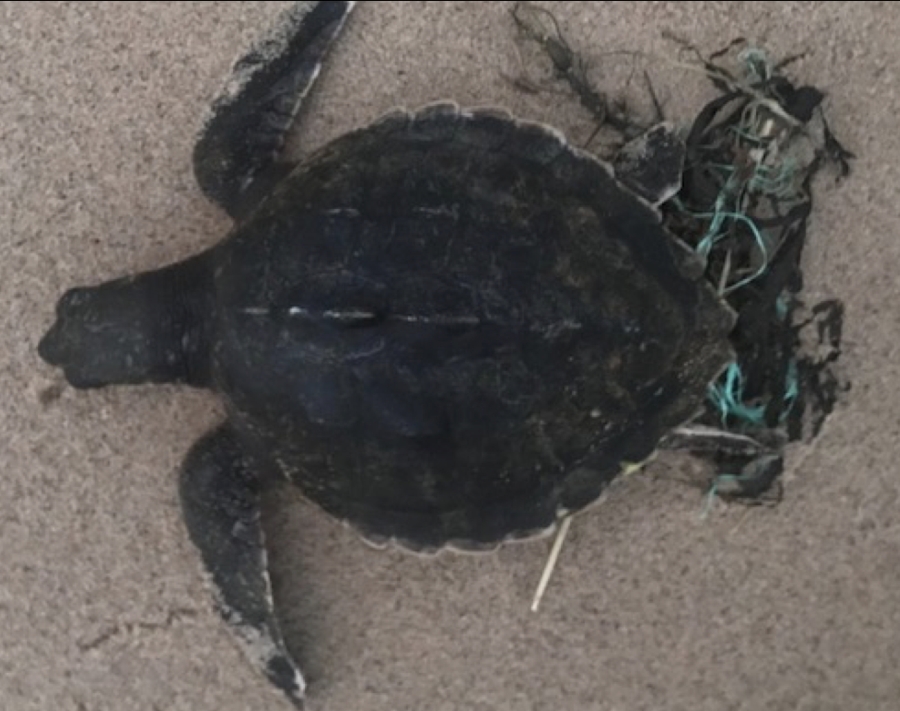
~ Cold-stunned Kemp's ridley sea turtle. Photo by Nancy Rabke.
Spring/Summer 2020
First, healthy hopes and thoughts to all reading this website. In a time of such uncertainty, it's good to think about sea turtles and their resiliency, despite the many threats that they face.
It won't be long before leatherbacks, loggerheads, Kemp's ridleys and greens will be arriving in our nutrient-rich New England waters to feed over the summer and fall. Mass Audubon's Wellfleet Bay Wildlife Sanctuary will be fully operating our sea turtle sighting hotline/website for boaters. We know boaters are beginning to get out on the water, so please report any sea turtle sightings online at seaturtlesightings.org, or by phone at 888-SEA-TURT (888-732-8878). We hope that your sightings will be of live, free-swimming sea turtles, but if you spot an entangled, or a dead, floating turtle, it's very important to report that, also. As in previous years, if you leave contact information we will call or email to discuss your sighting and answer questions.
WBWS sea turtle staff will continue to respond to spring/summer/early fall sea turtle strandings as well. Please remember that many of these strandings—typically single, dead sea turtles washed up on a beach— show clear evidence of severe vessel strike. So, watch out for sea turtles in the water to avoid hitting them, report sightings, and have a safe, healthy summer!
You can read about Mass Audubon’s Covid-19 response actions.
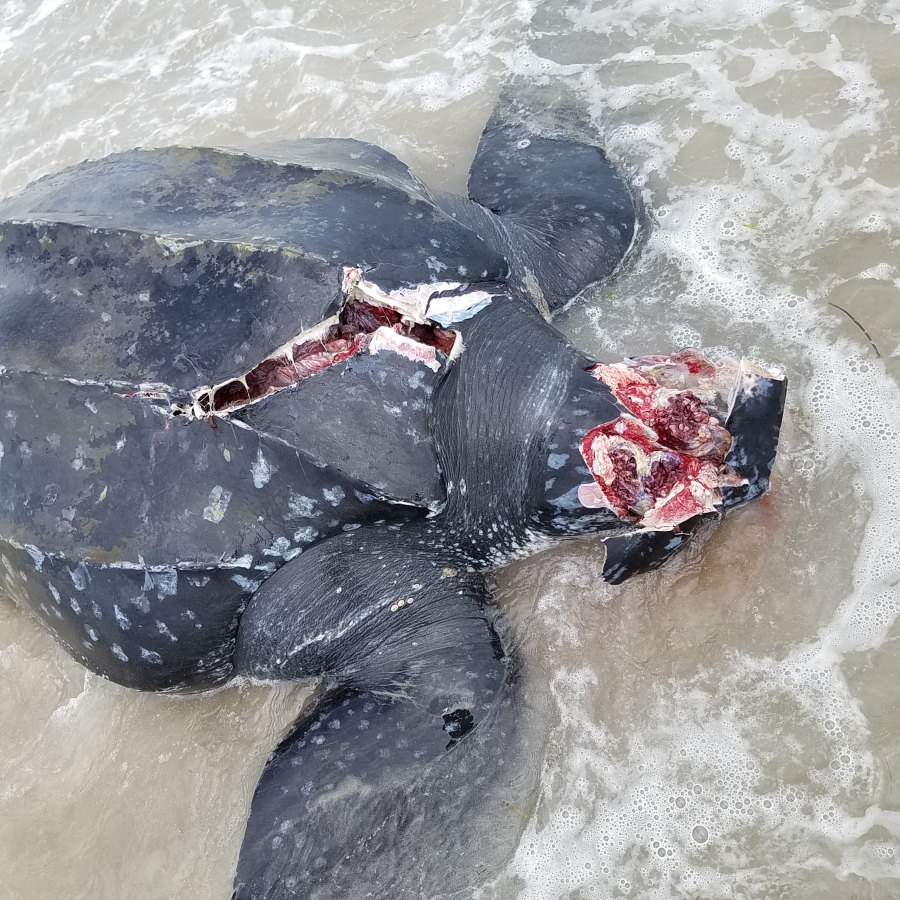
~ leatherback photo by WBWS staff.
Fall 2019
Leatherbacks are still feeding in our waters. If you're out on the water, please keep reporting them and watch carefully to avoid striking one with your vessel.
The cold-stunned sea turtle season is rapidly approaching, when Kemp's ridleys, loggerheads and greens wash ashore, mostly on the beaches surrounding Cape Cod Bay, but occasionally on the north shore of Martha's Vineyard and Nantucket and around Buzzards Bay. Mass Audubon Wellfleet Bay Wildlife Sanctuary operates a large rescue operation for these cold-stuns, using sea turtle staff and over 250 trained volunteers. If you're walking a beach and find a stranded sea turtle, assume that the turtle is alive and please follow these steps:
- Move turtle to above the high tide line
- Cover it with dry seaweed (wet if dry not available)
- Clearly mark it with piece of debris or draw arrow in sand pointing to covered turtle
- If in Massachusetts call Mass Audubon Wellfleet Bay at 508-349-2615 ext. 6104
- If in another state call NOAA at 866-755-6622

~ First Live Green of the 2019 Fall Season with Chuck Dowd.
Summer 2019
They're here! The summer sea turtle sighting season has started, as sea turtles are migrating into feeding grounds in our waters and further north. The Mass Audubon Sea Turtle Sighting Hotline for Boaters received its first sighting for the 2019 season — a leatherback off Sakonnet Point, Rhode Island, on June 8. They got very good looks at a huge leatherback as it swam at the surface, then dove. They observed jellyfish in the same area, which are the leatherback's prey. Luckily, this turtle appeared healthy, with no visible wounds or entangling lines or fishing gear. Remember that loggerheads are smaller (often trashcan–lid size), and brownish with yellowish markings around the head and flippers.
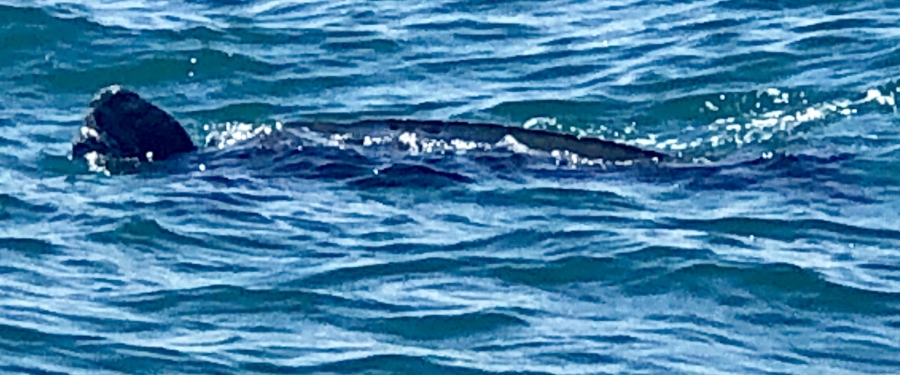
~ leatherback photo by Nicole LaRoche.
Sadly, we've also had our first summer stranded sea turtle — a vessel–struck leatherback which stranded at Horseneck Beach in Westport, MA, on June 16. Vessel strikes occur all too frequently in our waters. You can help keep sea turtles healthy. If you're a boater, please watch carefully ahead of your boat, and do not use autopilot — autopilots do not see sea turtles! Pass the word to boaters you know, and please remember to report any sea turtle sightings to seaturtlesightings.org.

~ leatherback photo by WBWS staff.
Spring 2019
Longer daylight hours, warmer air temperatures, boat covers coming off—all mean that boaters start thinking about the upcoming season of enjoying our beautiful waters. It won't be long before the first sea turtles return to New England waters to begin feeding. The earliest local, credible sea turtle sighting our hotline has received was a loggerhead off the Chatham, MA fish pier, on April 22, 2012. So, please refresh your mental images of what our four species of sea turtles might look like from your boat. Once on the water, keep a close eye ahead of your boat, and If you see a sea turtle, please report it!
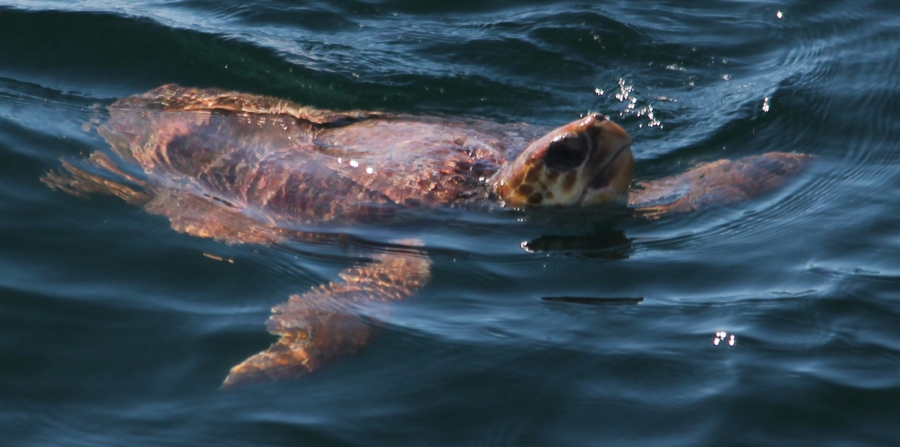
~ loggerhead photo by Amy Warren, Newburyport Whale Watch.
Late Fall/Early Winter 2018
Cold-stunned sea turtle season has started, when juvenile Kemp's ridleys, juvenile greens, and juvenile and subadult loggerheads have become trapped in our northern waters, many by the geological "hook" of Cape Cod. These young sea turtles become colder and colder, eventually unable to swim or feed. Onshore winds blow them onto beaches around Cape Cod Bay, and Mass Audubon Wellfleet Bay Wildlife Sanctuary trained volunteers patrol the beaches after high tide to find them. Many are still alive, are brought to Wellfleet Bay Sanctuary, then are driven to New England Aquarium's rehab facility. Their survival rate is high, and these are eventually released in warm southern waters.
If you find a sea turtle on the beach, it may look dead but it's probably alive. If you find a sea turtle on the beach, please follow this protocol:
- Move the turtle carefully to above the high tide line.
- Cover it loosely with dry seaweed.
- Mark the spot clearly with a vertical stick or beach debris, or draw a large arrow in the sand (above the high tide line) pointing to the turtle's location.
- If in Massachusetts, call Mass Audubon Wellfleet Bay at 508-349-2615 ext. 6104
- If in a state other than Massachusetts, call NOAA's hotline at 866-755-6622
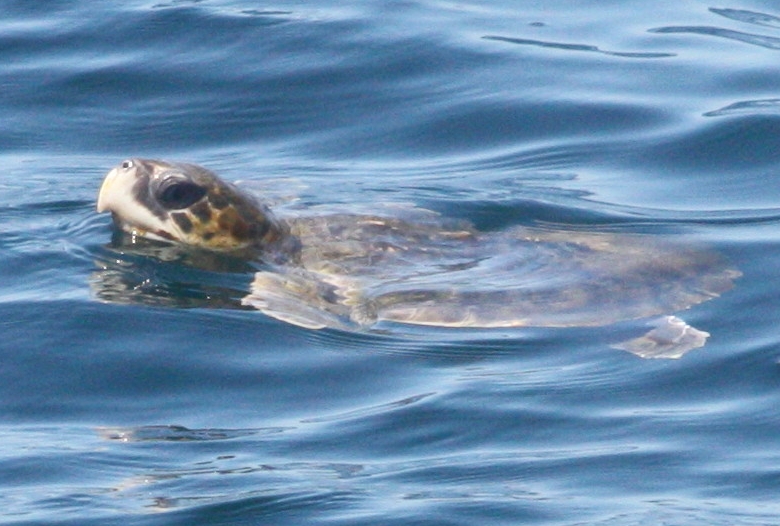
~ Kemp's ridley photo by J. Gwalthney,
F/V Eileen K
Fall 2018
Sea turtles are here, focused on feeding to build up fat reserves for southward migrations. Most sightings are of leatherbacks, which are eating jellyfish all around Cape Cod, Martha's Vineyard, Nantucket, and the Elizabeth Islands. This year we've partnered with the Martha's Vineyard Striped Bass and Bluefish Derby to get word out to fishermen and all boaters to watch for, report and avoid striking sea turtles. Some boaters report seeing up to seven leatherbacks close together, all feeding at the surface. Often the only part of a leatherback a boater might see above the surface is the head, which is about the size of a soccer ball and can look like a dark buoy. There are so many leatherbacks in Vineyard and Nantucket Sounds that the US Coast Guard issued a Notice to Mariners to reduce speed and watch for sea turtles. And if you're a boater, please remember: autopilots do not see sea turtles!

~ Swimming Leatherback, photo Melanie White, Granite State Whalewatch
Late Summer/Fall 2018
It's been a sparse summer so far in terms of leatherback sightings. Now that late summer is here, however, jellyfish are appearing in greater density, and this is what leatherbacks eat. Because leatherbacks eat huge quantities of jellyfish in our waters, leatherback numbers are increasing also. Tragically, so are vessel strikes. We can't overstate the importance of watching the water ahead of your boat, and please make yourself familiar with what sea turtles — especially leatherbacks and loggerheads — look like in the water. We understand that sometimes a vessel strike occurs when the helmsman is paying careful attention, as sea turtles can surface under a vessel or can swim just below the surface. We receive many reports, though, from boaters who say that their vessel would have hit a sea turtle if they hadn't been looking ahead. Last year leatherbacks were present off New England well into October, especially around Cape Cod, Martha's Vineyard and Nantucket. Enjoy our beautiful late summer/fall ocean waters. Please report any sea turtle sightings here at seaturtlesightings.org, and please stay alert when boating!
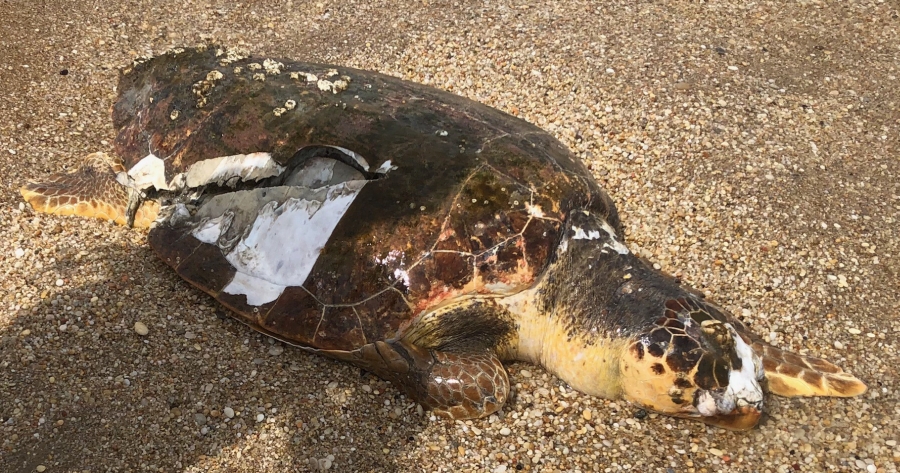
~ Dead, vessel-struck loggerhead showing propeller wound, photo by Bruce Faulkner
Summer 2018
The summer sea turtle season off southern New England is underway! The Mass Audubon Sea Turtle Sighting Hotline has received its first live, free-swimming loggerhead and leatherback sighting reports. Please read the Spring Update below, which details how to learn about the four sea turtle species in our waters, how to avoid striking them with your boats, and how to report sightings. Let's make Summer 2018 a season of boater awareness about sea turtles!
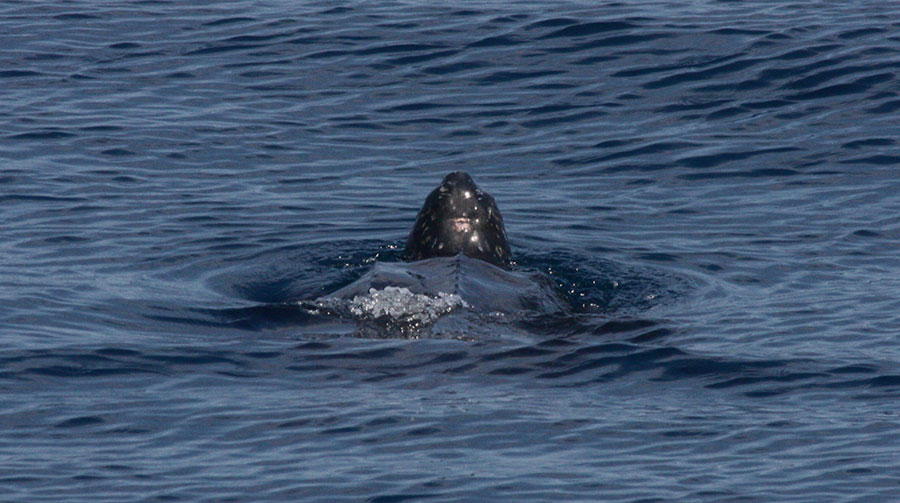
~ leatherback photo by J. Gwalthney, F/V Eileen K.
Spring 2018
Boaters are uncovering their boats and will be launching soon for the 2018 season. As you prepare for your summer boating, please remember that vessel strikes are a significant cause of death for sea turtles off southern New England. The 2017 season was especially brutal for leatherbacks and loggerheads around Cape Cod, with fourteen known vessel-struck leatherbacks and six loggerheads. Reducing threats to wildlife and the environment can seem daunting at times, but in terms of sea turtles, there are real ways that boaters can minimize the risk of hitting and killing them. As responsible boaters, you can learn about the four species of sea turtles that are in our waters in the late spring, summer and fall. Looking at photos and reading descriptions can help form mental "search images" — i.e. what the sea turtles would look like ahead of your boat. You can enlist the help of your passengers, who will be thrilled if they see a live sea turtle. And please remember: report any sea turtles that you see, and AUTOPILOTS DO NOT SEE SEA TURTLES!

~ loggerhead photo by Amy Warren, Newburyport Whale Watch.
Early Winter 2017
Three species of sea turtles are still here, but the mode of seeing them has changed. Not many boaters are out, but juvenile Kemp's ridley, loggerhead and green sea turtles are becoming "cold-stunned", when their body temperatures drop so low that the turtles' metabolisms slow down, making them unable to feed or migrate. These cold-stuns, mostly Kemp's ridleys, have started washing onto beaches around Cape Cod Bay, where they are rescued by volunteers and staff at Wellfleet Bay Wildlife Sanctuary. These cold-stunned turtles often look dead, but many are still alive. They are driven to New England Aquarium's rehab facility in Quincy, MA, where they begin the healing process enabling them to be returned to the wild in warmer waters.
If you find one of these cold-stunned sea turtles on a beach, please move it
carefully above the high tide line, cover it with dry seaweed, mark the spot
with something like a stick standing vertically in the sand with a piece of
colorful beach debris on top, or draw a large arrow in the sand. Just think
about how to make it visible to a staff member retrieving the turtle. If the
turtle is in Massachusetts, please call Mass Audubon Wellfleet Bay Wildlife
Sanctuary,1-508-349-2615, ext. 6104. If the turtle is in another state, please
call the NOAA hotline at 1-866-755-6622.
Thank you!

~ Kemp's ridley photo by J. Gwalthney,
F/V Eileen K
Late Summer 2017
Although the season had a late start, leatherbacks are here now in a big way! There are lots of jellyfish and other gelatinous organisms in the waters around Cape Cod, and the leatherbacks are gobbling them up. Although we're glad to see the leatherbacks here, our waters also mean trouble for them from boat strikes and entanglement in vertical line fishing gear. Please keep a close eye out for leatherbacks, which are black, often with white spots, and for loggerheads, which are tan/brown with yellow/orange around their heads and flippers. Both species sometimes swim at or just under the surface. Your small power boat could easily kill a loggerhead or a huge leatherback. If you see a free-swimming sea turtle please report it to us at seaturtlesightings.org or 1-888-SEA-TURT. And if you see an entangled sea turtle, please call the Center for Coastal Studies' hotline (800-900-3622) and stand by in your boat, if possible. Your attention on the water and your concern can help save these threatened and endangered species.

~ leatherback photo by J. Gwalthney, F/V Eileen K.
Summer 2017
The 2017 sea turtle sightings season has begun! It's been a late start, probably due to cool weather causing a delayed start for the recreational boating season and a slow rise of ocean temperatures. But we've had our first reports of leatherbacks in Nantucket Sound and in Buzzards Bay, and a loggerhead off Westport, Massachusetts.
This year we're focusing increased attention on trying to prevent boat strikes. In September, 2016, we responded to two leatherbacks killed by boat strikes, one washed ashore on Nantucket and one in Mashpee, Massachusetts. Both were females which had been PIT (passive integrated transponder) tagged as they nested in previous years in tropical waters – one in Trinidad and one in Anguilla. It's extremely sad to lose any sea turtles as they feed in our waters, but it's an especially big loss when they are reproductive females. Sea Turtles, especially leatherbacks, are also vulnerable to entanglement and ingestion of plastic, but fatality from boat strikes can be reduced with increased boater attention and awareness. So now it's up to you boaters to be on the look-out for sea turtles. Please study the photos here on the website and familiarize yourself with what our four species might look like from your boat. Keep a sharp eye from the helm – autopilots don't see sea turtles – and remember that we share the water with many species of marine wildlife. It'll be your lucky day if you see a sea turtle, and please report it!

~ loggerhead photo by Amy Warren, Newburyport Whale Watch.
November 2016
Cold-Stunned Sea Turtle Season
The cold-stunned season is starting "late" again this year, although
with warming Gulf of Maine waters this may be the new "normal". The
first cold-stun was picked up on October 25, but as of November 12 there
have only been eight: five Kemp's ridley (one dead) and three live
greens. The live turtles are taken to New England Aquarium's Quincy, MA
facility, where their health is assessed and they undergo any necessary
treatment and rehabilitation for later release further south. We expect
many more juvenile Kemp's ridley, loggerhead and green sea turtles to
strand as their body temperatures drop to the point where they can't
swim or eat and they wash ashore, hopefully alive, with onshore
winds.
If you find a sea turtle on the beach at this time of year, please do the following:
- Do not put the turtle back in the water — it won't survive
- Move the turtle above the high tide line
- Cover it with dry seaweed (to block the wind)
- Mark the location with debris, such as vertical sticks or a bright piece of weighted- down plastic
- If turtle is in Massachusetts call Mass Audubon Wellfleet Bay 508-349-2615 ext. 6104
- If turtle is in another state, call the NOAA Marine Animal Hotline 866-755-6622

~ Kemp's ridley photo by J. Gwalthney,
F/V Eileen K
Late Summer 2016
Every year is interesting regarding sea turtles, and this year has proven to be no exception. Through July, sightings of live, free-swimming leatherbacks off New England were sparse, although loggerheads were reported in fairly typical numbers. Sea surface temperatures are extremely warm, and it may be that it has been too warm in at least some areas for lion's mane, one species of cool-water jellyfish that leatherbacks eat. Leatherback reports have picked up in August, however, as have reports of ctenophores (comb jellies) and sea nettles, two types of gelatinous organisms eaten by leatherbacks.
In the past few weeks we've been responding to more dead loggerheads washed up on beaches. At least two of these had wounds in their carapace (upper shell) from motorboat propellers. Others have shown no obvious cause of death. These may have been caught in gear, couldn't get to the surface to breathe, and drowned. Although we learn from each dead sea turtle as it is studied and recorded, we all would rather see them alive and healthy, swimming and feeding in our waters. So boaters, please keep an eye out for sea turtles, especially on boat transits across open bodies of water where it may be tempting to relax at the helm. The life of a sea turtle may depend on you. And if you do see a turtle, please report it here.
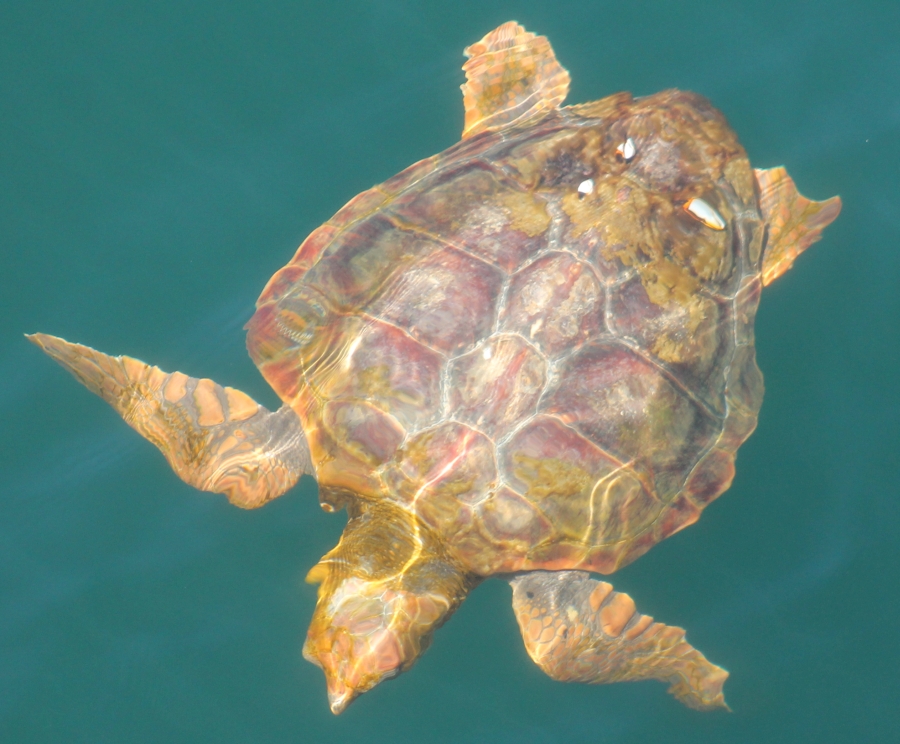
~ loggerhead photo by Amy Warren, Newburyport Whale Watch.
May 2016
They're here! The first live sea turtle sighting reported in our waters for 2016 was May 24, off Gardner's Neck, in Mt. Hope Bay, Swansea, MA. A man fishing on a stone jetty watched as a "copper-brown with some yellow, 1 – 1.5 ft. diameter sea turtle" swam around at the surface for about five minutes. This very aptly describes a juvenile loggerhead. "It looked like it was hunting for food," the reporting party stated, which it probably was.
As the boating and recreational fishing season gets underway, please remember to watch for the four species of sea turtles which feed in our waters in the late spring, summer and early fall. Click on theTurtle Info page on this website to read about and see photos of these species. Often we find that if boaters have search images in mind while being out on the water, they are more likely to spot turtles basking or swimming at, or near, the surface. Remember that the leatherbacks can be as long as 8 – 10 ft., sometimes resembling a dark rock or an overturned dinghy, and the juvenile Kemp's ridleys can be as small as a dinner plate. And please remember that you share the water with these endangered species, and their lives may depend on your being watchful.

~ loggerhead photo by Amy Warren, Newburyport Whale Watch.
Spring 2016
The 2015-2016 winter was busy, with the cold-stunned sea turtle event shifting later (start and finish), due to warmer ocean water temperatures. It was the second highest season yet for recorded numbers of cold-stunned sea turtles in Massachusetts — over 600. Thanks to massive efforts by staff and volunteers from MassAudubon Wellfleet Bay Wildlife Sanctuary, New England Aquarium, and other organizations, more than half of these cold-stunned sea turtles survived. Many have already been rehabilitated and released in southern waters, and some are still in rehab and will be released locally this summer when waters warm sufficiently. Cold–stunned turtles that died were necropsied by researchers to learn as much as possible from these endangered and threatened marine species.
We're ready for the 2016 season of live sea turtle sightings. As boaters prepare for the upcoming season, please remember that sea turtles will be out there, too. Their survival often depends on your vigilance in watching the water in your boat's path. Please keep in mind our Sea Turtle Sighting Hotline — report sightings either online (seaturtlesightings.org) or by phone (1-888-732-8878) — each sighting is important.
There is growing evidence that your live sighting reports may help us predict, and prepare for, the magnitude of the cold-stunned sea turtle season starting in late fall. We always appreciate your sharing photos with us, and we are especially looking for photos of the smaller juveniles that occur in our waters — Kemp's ridley and green sea turtles. Thank you for your help in the past, and we look forward to the first 2016 reports of live sea turtles off southern New England.

~ Green Turtle photo by Krill Carson, NECWA.
October 2015
The 2015 sea turtle season has been another interesting one. There were fewer reports of leatherbacks than usual, with no reports of large, spread-out aggregations of leatherbacks which have been seen in some recent years. Reports of loggerheads were up. Data from stranded, dead loggerheads indicate that we are seeing more large individuals in our waters than in years past.
Although the recreational boating season is mostly over, we know that three of our four species, Kemp's ridley, loggerhead and green sea turtles, are still here, "trapped" by the geography of Cape Cod and by the cold water north and east of the Cape. We are geared up for the 2015 "cold-stunned" sea turtle season. You can read more about this phenomenon and how the 2014 cold-stunned season broke all previous records.
Since three of our four species of sea turtles are federally listed as "endangered" and one as "threatened", each sighting is important. Look at the 2015 sighting maps to see where sea turtles were reported in 2015. Thanks to all of you who reported sea turtles, and we look forward to your help next year.

~ Kemp's ridley photo by J. Gwalthney,
F/V Eileen K
August 2015
Sea turtle sightings got off to a rather slow start, but now are coming in steadily. So far, it seems to be the “year of the loggerhead”, as sighting reports of these hard-shelled sea turtles are higher than usual. Unfortunately, strandings are also steady, with sea turtle carcasses exhibiting wounds from either boat propellers or gear entanglement. Sea surface temperatures are high throughout southern New England coastal waters, and we expect sea turtles to be feeding in our area for quite some time. Sea turtles surface to breathe, but they also sometimes bask or swim at or just below the surface, so boater awareness is crucial for avoiding striking the turtles. Please continue reporting sightings, and thank you for spreading the word to other boaters.
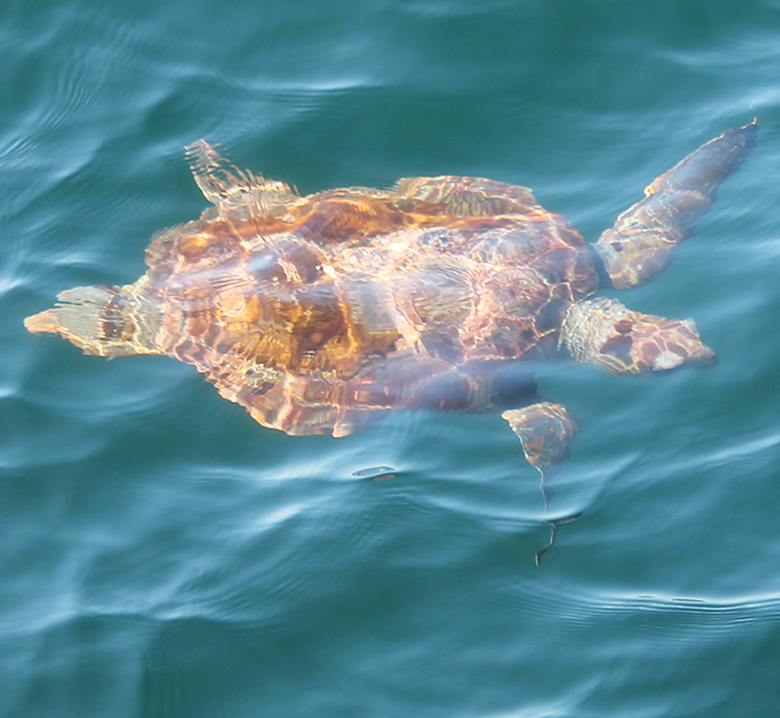
~ Loggerhead photo by Amy Warren, Newburyport Whale Watch
Spring 2015
Onshore winds of late fall/early winter, 2014, washed record numbers of cold-stunned sea turtles onto southern New England beaches, especially around Cape Cod Bay. More than 1200 sea turtles were stranded—mostly Kemp’s ridley. Through generosity and intensive efforts by staff and volunteers from many organizations, we’re hoping to return over 60% to the wild. Your sightings of live, free-swimming sea turtles in summer and fall, 2015, are more important than ever to help us better understand how sea turtles are using our waters. There is also some indication that opportunistic sightings of the hard-shelled species (loggerhead, green, and Kemp’s ridley) may help us predict and prepare for the 2015 cold-stunseason. Please report sea turtle sightings!
